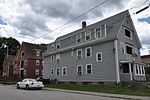Building at 38–42 Worcester Street
Apartment buildings on the National Register of Historic Places in MassachusettsBuildings and structures completed in 1878Buildings and structures in Southbridge, MassachusettsNational Register of Historic Places in Southbridge, Massachusetts

The Building at 38–42 Worcester Street is a historic six-unit triple decker in Southbridge, Massachusetts. Built sometime between 1878 and 1898, it has features influenced by the area's then-growing French Canadian immigrant population, including its outside porches. The building was listed on the National Register of Historic Places in 1989.
Excerpt from the Wikipedia article Building at 38–42 Worcester Street (License: CC BY-SA 3.0, Authors, Images).Building at 38–42 Worcester Street
Worcester Street,
Geographical coordinates (GPS) Address Nearby Places Show on map
Geographical coordinates (GPS)
| Latitude | Longitude |
|---|---|
| N 42.079444444444 ° | E -72.029722222222 ° |
Address
Worcester Street 35
01550
Massachusetts, United States
Open on Google Maps











